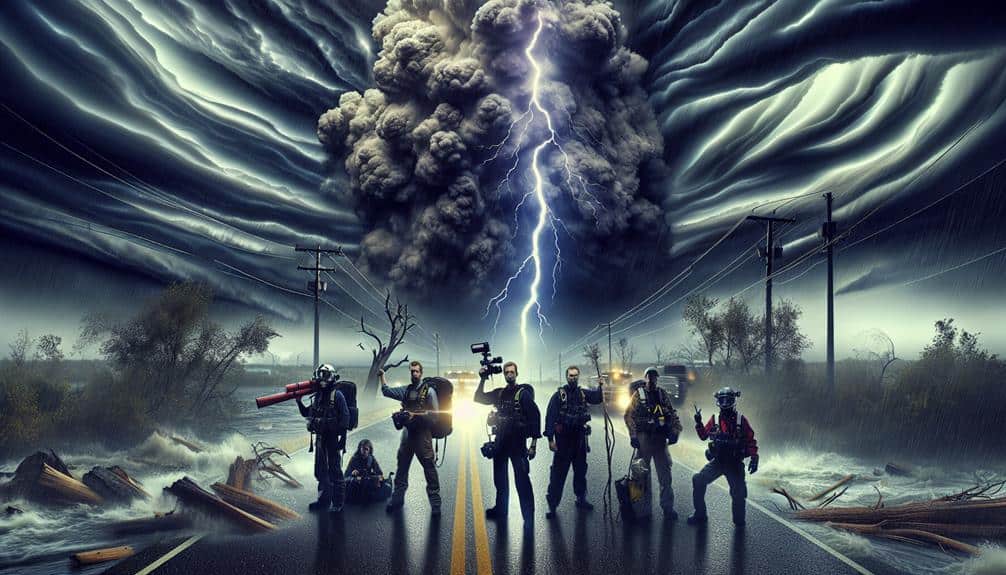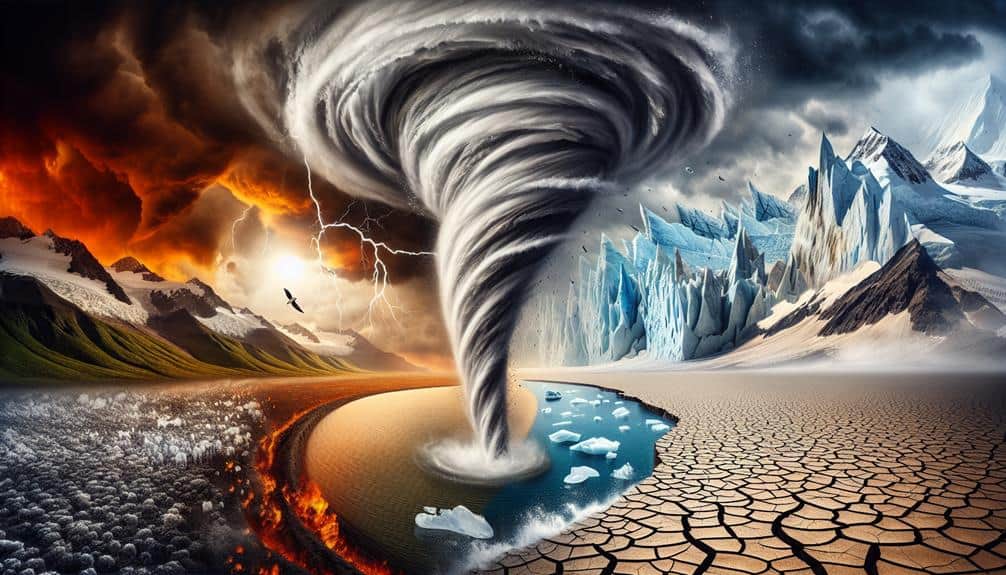Climate change is transforming storm chasing as we see increased storm intensities driven by warmer sea surface temperatures and shifts in storm patterns with erratic paths. There's a noticeable rise in tornado outbreaks and thunderstorm incidents, with some regions experiencing up to a 20% increase. Tornado Alley is moving eastward, creating new storm hotspots. Advanced technologies like improved Doppler radar, satellites, and machine learning now offer precise predictions, enhancing our capabilities but also presenting safety challenges in the face of intensifying and unpredictable weather. Understanding these dynamics is essential to grasp the evolving nature of storm chasing today.
Key Points
- Warmer sea surface temperatures are increasing storm intensities, making storm chasing more dangerous and unpredictable.
- Shifts in storm paths and erratic patterns are leading to tornadoes in regions previously not prone to such events.
- The frequency of tornado outbreaks and thunderstorms is rising, necessitating advanced technology for accurate and timely forecasting.
- New storm hotspots are emerging, requiring storm chasers to adapt to previously uncharted territories.
Rising Storm Intensities
Over the past decade, we've observed a noticeable increase in storm intensities, corroborated by thorough meteorological data. This trend is consistent across numerous studies that link extreme weather events to broader climate impacts.
For instance, data from the National Oceanic and Atmospheric Administration (NOAA) reveals a marked rise in the frequency and severity of Category 4 and 5 hurricanes. These hurricanes exhibit higher wind speeds and more significant precipitation, posing increased risks to coastal and inland areas alike.
Our analysis indicates that warmer sea surface temperatures, a direct result of global warming, contribute substantially to these rising storm intensities. Warmer waters provide the energy necessary to fuel more potent storms, leading to more extreme weather patterns.
Additionally, the increased moisture in the atmosphere results in heavier rainfall during these events, exacerbating flooding risks.
We can't ignore the broader climate impacts, either. The Intergovernmental Panel on Climate Change (IPCC) reports emphasize that these heightened storm intensities are part of a larger pattern of climate change-induced disturbances.
As we continue to gather data, the correlation between rising global temperatures and storm severity becomes increasingly evident. This necessitates not only improved predictive models but also a reevaluation of our preparedness and response strategies.
Changing Storm Patterns
In addition to intensifying storms, we've observed shifts in storm patterns, with storms now occurring in regions and seasons previously considered unusual. Data from the National Oceanic and Atmospheric Administration (NOAA) indicates that storm paths are increasingly erratic, affecting areas historically less prone to extreme weather events.
For instance, tornadoes, once confined mainly to the central U.S., are now being reported in the Southeast and even in parts of the Northeast. This shift is significant for storm chasers who must adapt to these changing storm paths. Advanced predictive models are crucial, yet they must now account for a wider range of variables, including altered jet streams and oceanic temperature anomalies.
A study from the American Meteorological Society highlights that irregular storm patterns complicate traditional forecasting methods, often leading to less predictable and more hazardous chases. The implications for public safety are profound. Emergency response strategies, historically focused on well-established storm tracks, must be re-evaluated to mitigate the risks associated with these extreme weather events.
As storm chasers, our role becomes even more important in tracking and understanding these changes to provide timely, accurate data for forecasters and communities alike.
Increased Storm Frequency
We're observing a notable rise in both tornado outbreaks and thunderstorm incidents, backed by recent meteorological data.
The frequency of these severe weather events has increased, correlating with climate change patterns.
More Frequent Tornado Outbreaks
Recent studies indicate a significant increase in the frequency of tornado outbreaks, driven by climate change. Scientific research shows that extreme weather events, including tornadoes, are becoming more common as global temperatures rise. This increase in tornado frequency challenges our current storm-chasing strategies and necessitates revisiting our approaches to climate adaptation and emergency response.
We've observed a notable rise in multi-tornado events, which demand more in-depth data collection and analysis. Meteorologists have found that warmer temperatures and altered atmospheric conditions contribute to the formation of more frequent and intense tornadoes. This shift requires us to enhance our predictive models and early warning systems to better protect communities.
Our emergency response teams must adapt to this new reality. The traditional methods of preparing for isolated tornadoes are no longer sufficient. We need to develop more thorough, flexible strategies that can address the complexities of multiple, simultaneous outbreaks.
Additionally, public awareness and education campaigns are essential in helping individuals understand and respond to the heightened risk of tornadoes.
Rising Thunderstorm Incidents
How has the increased frequency of thunderstorms impacted our storm-chasing efforts and emergency preparedness strategies?
Over the past decade, data indicates a marked rise in thunderstorm incidents, with some regions experiencing up to a 20% increase. This uptick challenges our storm-chasing capabilities, requiring us to adapt both technologically and strategically.
With more frequent storms, the storm impact on infrastructure and communities is more significant, necessitating rapid response and real-time data analysis.
We've had to invest in advanced radar systems and satellite monitoring to keep pace with the escalating frequency. This technological climate adaptation allows us to predict storm paths more accurately, enhancing our ability to chase storms safely and effectively.
On the flip side, emergency preparedness strategies have evolved to include more robust communication networks and faster mobilization of resources.
Public education campaigns focus on resilience and preparedness, teaching communities how to respond quickly to storm warnings. These efforts aim to reduce the storm impact on human life and property.
New Storm Hotspots
We've observed that Tornado Alley is shifting eastward, which aligns with recent climate models. This shift results in more unpredictable weather patterns, complicating storm predictions.
Our data highlights the need to adapt our storm-chasing strategies to these emerging hotspots.
Shifting Tornado Alley
Tornado Alley is shifting eastward, with data showing an increase in tornado frequency and intensity in states like Tennessee, Kentucky, and Mississippi. This migration of tornado activity is altering how we approach storm tracking and climate adaptation.
Historically, Tornado Alley was centered in the Great Plains, but recent studies reveal a notable eastward shift. For instance, analysis of tornado occurrences from 1979 to 2019 indicates a significant rise in tornado days in the southeastern United States.
Our storm tracking methods must evolve to account for these new pivotal hotspots. Advanced radar technology, combined with machine learning algorithms, can help us better predict and monitor these shifting tornado zones. This data-driven approach enables us to adapt our emergency response strategies and improve public safety measures.
Climate adaptation is also essential. As tornadoes become more frequent in these eastern regions, local governments and communities must invest in infrastructure that can withstand severe weather. Building codes need updating to reflect the increased risk, and public awareness campaigns should focus on preparedness and resilience.
Unpredictable Weather Patterns
Emerging data highlights the formation of new storm hotspots beyond traditional boundaries, calling for a reassessment of our meteorological models and forecasting strategies. As climate impact intensifies, regions previously deemed secure from extreme weather are now experiencing unprecedented storm activity. We're witnessing a shift in storm frequency and intensity, which directly challenges our existing models and predictive capabilities.
The increased unpredictability in weather patterns demands that we adapt quickly. Traditional hotspots like Tornado Alley are no longer the sole focus. Areas in the Midwest, Northeast, and even the Western U.S. are reporting more frequent and severe storms. This expansion requires more extensive data collection and advanced modeling techniques to accurately predict these events.
We must integrate real-time data analytics and machine learning to enhance our forecasting accuracy. By doing so, we can better prepare communities and mitigate the risks associated with extreme weather. The climate impact on storm patterns is undeniable, and our responsibility is to stay ahead of these changes.
Realigning our focus to include these new storm hotspots guarantees we're not caught off guard and can continue to protect lives and property effectively.
Advanced Predictive Technologies

Advanced predictive technologies are revolutionizing storm chasing by providing more accurate and timely forecasts, allowing for better preparedness and response. With improved forecasting accuracy and enhanced storm detection, we've witnessed a significant shift in how we approach storm chasing.
Leveraging cutting-edge tracking systems, meteorologists and storm chasers can now access real-time data analysis, which offers an unprecedented level of detail about storm development and movement.
For instance, Doppler radar advancements have dramatically enhanced storm detection capabilities. These systems can now pinpoint the exact location and intensity of storms, providing vital information that helps us predict their paths more precisely. Additionally, satellite technology has improved, offering high-resolution images that allow us to monitor storms from space, further strengthening our predictive capabilities.
We also benefit from machine learning algorithms, which analyze vast amounts of historical weather data to identify patterns and make more precise predictions. This real-time data analysis allows us to anticipate storm behavior with greater confidence, enabling more strategic decision-making during storm chasing missions.
The integration of these advanced technologies not only enhances our ability to forecast storms but also guarantees we're better equipped to navigate the increasing unpredictability brought on by climate change.
Safety Challenges for Storm Chasers
Despite significant technological advancements, storm chasers still face significant safety challenges due to the increasing intensity and unpredictability of severe weather events. The heightened variability in storm patterns, driven by climate change, complicates our efforts in risk management. Data shows that storms aren't only becoming more intense but also less predictable, making traditional forecasting models less reliable. This unpredictability increases the difficulty in positioning ourselves safely while capturing critical data.
Emergency preparedness is another vital aspect that's becoming more complex. While we can equip ourselves with the latest gear and communication tools, the rapidly changing conditions demand real-time adjustments and split-second decision-making. A study by the National Oceanic and Atmospheric Administration (NOAA) indicates that the frequency of severe weather events has increased by 40% over the past decade, further elevating the risk factors we face.
Moreover, we must consider the human element in these high-stress situations. Fatigue, cognitive overload, and the sheer unpredictability of storms can lead to lapses in judgment. Therefore, continuous training and psychological preparedness are indispensable components of our risk management strategy.
Ultimately, our commitment to safety must evolve alongside the escalating challenges posed by climate change.
Evolving Storm Chasing Techniques
Given the increasing safety challenges, we're compelled to develop and adopt innovative storm chasing techniques that enhance both our predictive accuracy and real-time responsiveness. One pivotal innovation is the deployment of drone surveillance. Drones allow us to gather high-resolution data from within the storm system, providing unprecedented insights into storm structure and dynamics. This data, when combined with real-time tracking technologies, enables us to monitor storm evolution with pinpoint precision.
Climate adaptation is another critical component of our evolving approach. Traditional storm forecasting models often fall short in the face of rapidly changing climate patterns. By integrating advanced algorithms that account for these shifts, we can improve our predictive models and make more accurate forecasts. This, in turn, enhances our ability to anticipate severe weather events and adjust our strategies accordingly.
Moreover, the integration of real-time tracking systems with mobile applications empowers us to relay information instantly, ensuring that both chasers and the public remain informed and safe. These advancements not only bolster our operational efficiency but also uphold the principles of freedom and informed choice, allowing us to navigate the increasingly volatile weather landscape effectively and responsibly.
Frequently Asked Questions
How Is Climate Change Affecting Wildlife in Storm-Prone Areas?
Climate change challenges wildlife habitats, compelling creatures to constantly adapt. Biodiversity suffers, yet some species show remarkable resilience. We must protect these ecosystems to secure freedom for all species to thrive despite heightened storm threats.
What Economic Impacts Are Communities Facing Due to Increased Storm Activity?
We're seeing significant economic struggles due to increased storm activity. Communities face infrastructure damage and rising insurance costs, but community resilience remains strong. Data indicates these impacts challenge freedom, urging adaptive strategies for sustainable recovery.
Are There Any Health Risks for Storm Chasers Due to Changing Weather Patterns?
As thrill-seekers, we face new safety concerns and equipment needs. Health risks are escalating, but with thorough preparation strategies, we can mitigate dangers. Adapting to changing weather patterns guarantees we continue to chase storms safely and freely.
How Can Local Governments Better Prepare for Climate-Induced Storms?
We should prioritize emergency response training and invest in infrastructure development. Data shows that well-prepared communities recover faster and sustain less damage from climate-induced storms. Effective measures will secure our freedom to thrive despite increasing storm threats.
What Role Do Renewable Energy Sources Play in Mitigating Climate Change?
It is clear that renewable energy benefits the environment, reduces greenhouse gas emissions, and promotes sustainable solutions. By embracing solar, wind, and hydro power, we can effectively mitigate climate change and secure a cleaner, freer future for all.


